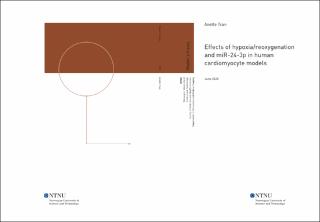| dc.description.abstract | Background: Effective cardioprotective therapies targeting the reperfusion phase of ischemia/reperfusion (I/R) injury are lacking, which remain one of the top unmet clinical needs in cardiology. MicroRNAs (miRNAs) are a class of small non-coding RNAs that regulate proteins at the post-transcriptional level. These molecules have recently been recognized as key players in the progression of heart disease. From previous data collected by the Group of Molecular and Cellular Cardiology at NTNU, miR-24-3p was found to be significantly upregulated in patients with post-MI HF. This miRNA has been found to target BIM, a pro-apoptotic member of the BCL-2 protein family. Therefore, we hypothesized that miR-24-3p may potentially have cardioprotective effects relating to apoptotic cell death. Technologies such as multi-well microelectrode arrays (MEAs) enable non-invasive recording of field potentials (FPs) of electrically active cells in vitro. This makes it possible to study the electrophysiological properties of human induced pluripotent stem cell-derived CMs (hiPSC-CMs), which closely recapitulate the function of native CMs in vivo. Taken together, the aims of this thesis were to (1) assess the temporal electrophysiological changes hiPSC-CMs exposed to in vitro I/R-simulated environments; (2) investigate potential cardioprotective effects of miR-24-3p-specific mimics and inhibitors on hiPSC-CMs in these environments; (3) verify the functional output from the hiPSC-CMs with molecular assay data collected from AC-16 CMs, an immortalized cell line fused with primary adult ventricular CMs.
Methods: A MEA system was used to record FPs of hiPSC-CMs in real-time. hiPSC-CMs and AC-16 CMs transfected with miR-24-3p-specific mimics and inhibitors were subjected to 18h hypoxia (1% O2) and 4h reoxygenation (20% O2). Parameters such as spike amplitude, spike slope, total active electrodes (TAE), and beats per minutes were assessed for hiPSC-CMs. For AC-16 CMs, RT-qPCR was used to determine mRNA expression levels of miR-24-3p and its targets, including BIM, and Western blotting used for determining the protein expression levels of BIM. To investigate the effects of miR-24-3p and hypoxia/reoxygenation on cell death, lactate dehydrogenase (LDH) and caspase-3 assays were performed in AC-16 CMs.
Results: TAE was reduced at the onset of hypoxia and at the onset of reoxygenation compared to baseline (p<0.05), while spike amplitude and spike slope were significantly reduced only during the latter (p<0.001). None of the parameters were significantly different from baseline at the end of the 4h reoxygenation period. MiR-24-3p did not have an effect on hiPSC-CM activity during hypoxia/reoxygenation. In AC-16 CMs, BIM mRNA expression was significantly upregulated during reoxygenation, compared to hypoxia (p<0.01) and normoxia (p<0.001). MiR-24-3p failed to suppress BIM mRNA expression levels in AC-16 CMs. The only significant difference seen in BIM protein expression levels was between the miR-24-3p mimic and inhibitor during hypoxia (p<0.05). Caspase-3 activity was elevated during hypoxia (p<0.05), but not reoxygenation. LDH activity increased during reoxygenation (p<0.001), however, data for the hypoxia condition from the LDH assay had to be excluded due to experimental errors. Therefore, it is not known whether LDH activity increased during hypoxia or not. Finally, caspase-3 and LDH activity was not influenced by miR-24-3p mimic nor inhibitor.
Conclusions: (1) Electrophysiological activity in hiPSC-CMs was reduced during hypoxia and worsened at the onset of reoxygenation. However, this was reversed with prolonged reoxygenation; (2) MiR-24-3p did not display significant cardioprotective effects in hiPSC-CMs exposed to hypoxia/reoxygenation, as there were no changes in functional output with neither the miR-24-3p mimic nor inhibitor; (3) In line with the data from hiPSC-CMs, miR-24-3p did not have a significant influence on AC-16 CMs. | |
